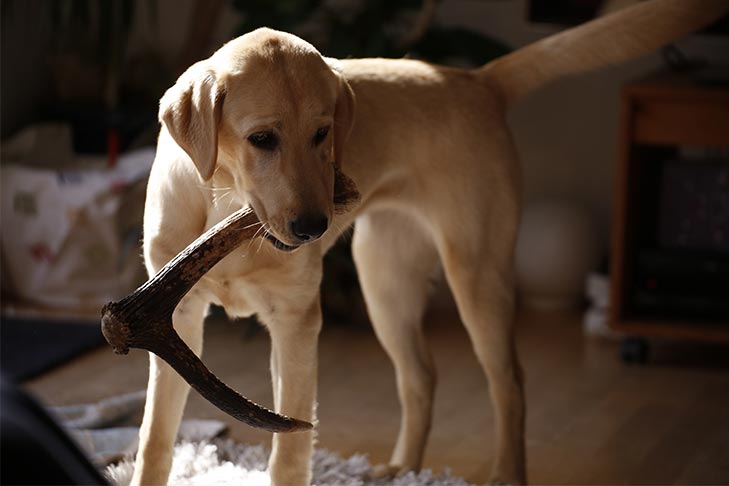If you’ve ever lost a shoe to your dog’s teeth, you know how much dogs love to chew. It relieves the pain of puppy teething, exercises jaw muscles, and cleans your dog’s teeth. Chewing is also great for beating doggy boredom and can help your dog relieve anxiety or frustration by giving them something enjoyable to focus on. Thankfully, there are all kinds of chew toys on the market. Your dog may also love edible dog chews.
How do you know which dog chews are safe? This guide to choosing the perfect chew will help you sort through the options.
Know Your Dog’s Style of Chewing
Every dog has their own chewing style. For example, a Boxer is more likely to be an aggressive chewer than a Shih Tzu. And every dog has their own chewing preferences. Some dogs like a harder chew and others prefer softer chews. Plus, as your dog ages, their preferences can change. The tough chews your dog enjoys as an adolescent will probably be too hard when they become a senior dog with dental issues.
Pick chews that suit your dog’s personality, age, and chewing style. What is safe for one dog might not be a good choice for another. A dog treat may be edible, but that doesn’t necessarily mean it’s safe. For example, if your dog breaks off large chunks and swallows them whole, that could lead to serious complications like choking or an obstructed bowel. Whenever you give your dog a new type of chew, always keep an eye on them to be sure it’s a safe choice.
What to Look for in an Edible Dog Chew
The following list will help you choose an appropriate chew:
- Hardness: Chews that are too hard can crack your dog’s teeth or cut their gums.
- Durability: The chew should be strong enough to withstand vigorous chewing. If it’s too soft, your dog can break off chunks and swallow them whole, which is a health hazard.
- Long-lasting: Look for edible dog chews that will last. These options will keep your dog occupied for longer and provide more value.
- Size: Chews that are too small for your dog present a choking risk. Pick edible dog chews that are large enough to prevent your dog from getting the entire thing in their mouth at once.
- Ingredients: Look for limited, natural ingredients. Avoid any flavorings or coatings that could upset your dog’s stomach.
If you have any concerns about your choice of edible dog chews, consult your veterinarian.

Types of Edible Dog Chews
Here are some of the more common chews.
Rawhide
Rawhide, which is made from the inner layer of horse or cowhide, is a popular chew, but rawhide safety depends on the dog. Power chewers can break off large pieces. If your dog swallows these chunks, they can choke, or the piece can become lodged in their intestines.
Rawhide is also difficult to digest. Pieces will pass through the digestive system whole, which is why they pose an obstruction risk. If you choose to provide rawhide, prevent your dog from eating large pieces by removing any chunks as soon as your dog breaks them off. Once your dog has chewed the rawhide so that it’s small enough to swallow in one piece, take it away from your dog.
Bully Sticks
Unlike rawhide, bully sticks, sometimes known as pizzle sticks, are easily digestible. Single-ingredient chews made from beef muscle, bully sticks range in thicknesses and lengths. They also come braided and shaped for an extra-long chew. They do not splinter. Instead, the end of the stick becomes soft and acts like a toothbrush as your dog chews.
Most dogs simply gnaw the end of the stick. However, power chewers might bite straight through, producing large pieces that pose a choking risk, or swallow the entire stick whole. In that case, you can try placing the treat in a bully stick holder, which prevents your dog from breaking off too much at once. When your dog has chewed the stick down to a nub, take it away before they can swallow what’s left.
Antlers
Antlers are all-natural chews that can come from a variety of animals, including deer or elk. Antlers for dogs come in a range of sizes and shapes and are incredibly long-lasting because they are so hard. However, their hardness can also make them a risky choice. Dogs can break their teeth on antlers, which is not only painful but expensive to treat. The hard surface can also cut your dog’s gums.

But the greatest risk is from a shard of antler that splinters off. These shards can puncture or get stuck in your dog’s mouth, throat, or intestines, leading to emergency surgery. Many veterinarians recommend avoiding antlers, but if you do provide them, always supervise your dog while they chew.
Yak Cheese Chews
A relatively new chew on the scene is the yak cheese chew. These hard blocks of dried cheese have just a few ingredients – yak’s milk (and sometimes cow’s milk), salt, and lime juice. The lactose content is low, so dogs generally digest them well, and they are hard enough to be long-lasting. Plus, they don’t smell as bad as some other animal-based chews.
However, these edible dog chews still pose the same dangers. If your dog breaks off chunks, they can swallow the pieces and risk choking or bowel obstruction. Also, although these are cheese, they are quite hard and could lead to broken teeth. As with other chews, only give your dog a block large enough that they can’t eat whole. Take away the yak chew as soon as it gets small enough to pose a hazard.
Tendons and Other Animal Parts
From beef trachea to pig ears, different animal parts are marketed as edible dog chews. Some are safer than others. Pig ears are often coated, which can upset your dog’s stomach. Backstrap and other tendon chews are a safer choice, since they’re low in fat and high in protein and collagen.
Trachea is a softer chew that contains chondroitin and glucosamine, so it can be a good choice for a dog with joint issues. Finally, fish skin chews are shaped into bones or rolls. Although they smell fishy, they are a great source of omega three fatty acids.
Human-Made Edible Bones
There is a whole range of human-made edible bones available. Often called dental bones, these edible dog chews often help clean dog teeth. Look for a version that is highly digestible with natural ingredients. And choose a bone size and shape appropriate for your dog’s size.








